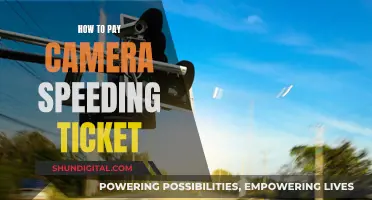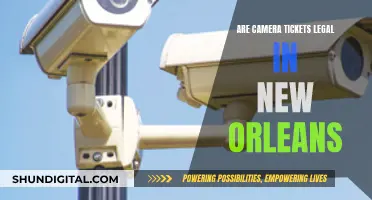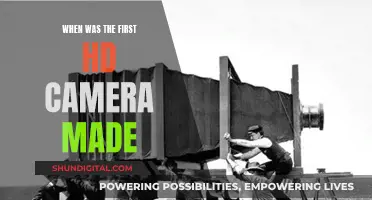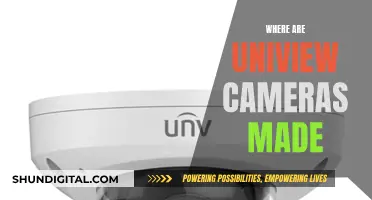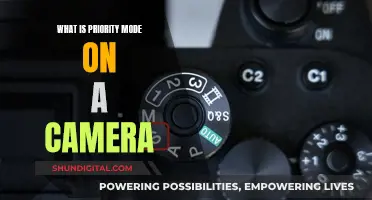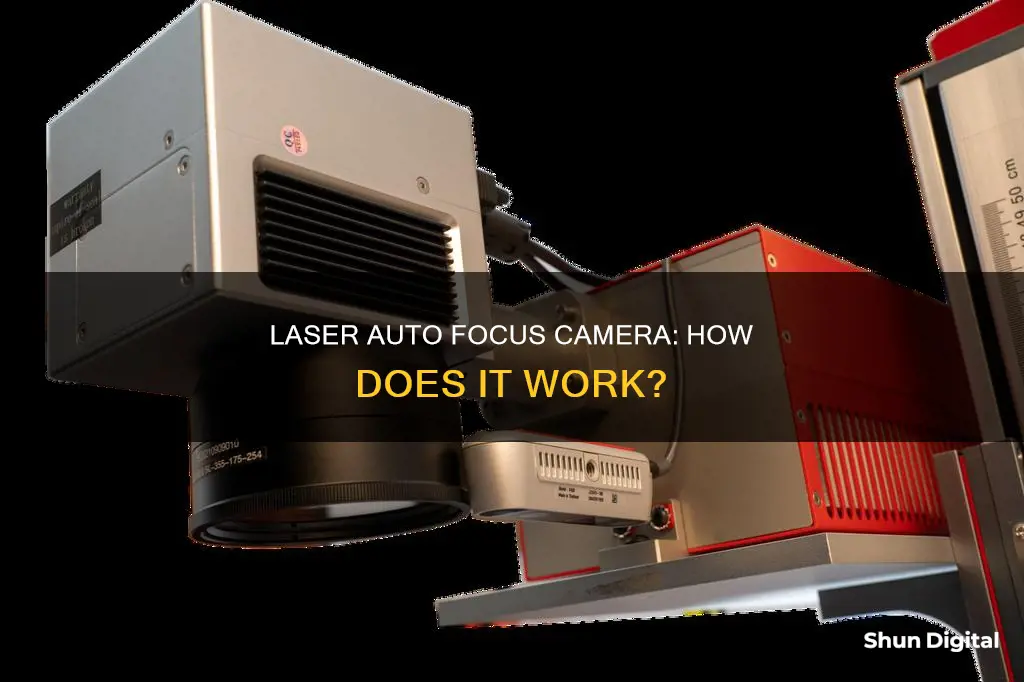
Laser autofocus is a camera feature that uses a laser emitter to calculate the distance to an object. When a photo is taken, the emitter sends out a short burst of laser light, which is reflected back and captured by the camera sensor. The software then calculates the time it takes for the laser to leave and return, giving an accurate measurement of the distance to the object. This information is used to adjust the camera's focus, resulting in sharper and more precise images. Laser autofocus was first introduced in the LG G3 smartphone and has since been adopted by other manufacturers, improving the autofocus capabilities of mobile cameras.
| Characteristics | Values |
|---|---|
| Type of autofocus | Active |
| Working principle | Laser autofocus uses the time-of-flight principle to calculate the distance to the object |
| Working distance | Effective up to 5m, best within 0.6m |
| Advantages | Super-fast, works in low-light conditions |
| Disadvantages | Expensive, requires additional hardware, can be confused by reflections |
What You'll Learn

Laser autofocus uses the same principle as LIDAR
Laser autofocus is a type of autofocus system used in smartphone cameras. It is also known as active autofocus as it does not rely on incoming light. Instead, the phone emits its own beam of infrared light towards the object. This is based on the same principle as LIDAR (Light Detection and Ranging), which uses laser light to measure distance.
In LIDAR, a short laser pulse is emitted from a source (transmitter) and reflected off objects in the scene. The time lapse between the outgoing light pulse and the detection of the reflected light pulse is recorded, and this is used to calculate the distance to the object. Similarly, in laser autofocus, a short laser burst is emitted from a small laser emitter positioned near the camera lens. This laser burst is reflected back from the object being photographed and enters the camera sensor. A software algorithm then calculates the time it takes for the laser to leave and return, which is used to measure the distance to the object. This information is then used to adjust the lens position and ensure the image is in focus.
The use of laser technology in autofocus systems offers several advantages. Firstly, it is a very fast method of autofocusing, with LG claiming that their laser autofocus system can focus an image in just 0.276 seconds. This makes it significantly quicker than other autofocus methods such as contrast-detection and phase-detection autofocus. Additionally, laser autofocus is effective in low-light conditions as it does not rely on incoming light. It can emit its own beam of light to determine the distance to the object, making it particularly beneficial for low-light photography.
However, there are also some limitations to laser autofocus. One drawback is that it is only effective up to a certain distance. According to LG, their laser autofocus system works best when the object is within 0.6 meters, with a total range of effectiveness of around 5 meters. Beyond this range, the phone will typically fall back to contrast-detection autofocus. Another issue is that laser autofocus can sometimes be confused by reflections. For example, if taking a photo through a window, the laser beam may be reflected by the window itself, resulting in an incorrect distance measurement and the image being focused on the window instead of the intended object. Furthermore, laser autofocus is generally more expensive and requires additional hardware, which may explain why it is currently only available on high-end smartphones.
Avoid Camera Tickets: Tips for Des Moines Drivers
You may want to see also

Laser autofocus is a type of active autofocus
Laser autofocus offers several advantages over other autofocus methods, such as contrast detection and phase detection. It is significantly faster, with focus times as low as 0.276 seconds, making it ideal for capturing fast-moving objects or scenes. It also works well in low-light conditions since it emits its own light source, whereas contrast detection relies on measuring the contrast in the scene.
However, laser autofocus has some limitations. It is most effective at short distances, typically within a range of 0.6 to 5 meters. Beyond this range, the laser beam may not receive any reflections, making it unreliable for focusing on distant objects. Additionally, it can be confused by reflective or transparent surfaces, such as windows, as the laser beam may be reflected or pass through these surfaces, resulting in incorrect distance measurements.
To overcome these limitations, some smartphones, such as the LG G3 and LG G4, combine laser autofocus with contrast detection in a hybrid system. This allows the camera to fall back to contrast detection when laser autofocus is ineffective, such as at longer distances or when dealing with reflective surfaces.
The Camera Obscura: Unveiling Its Intriguing Components
You may want to see also

Laser autofocus is quicker than contrast-detection autofocus
Laser autofocus is a unique system that is distinct from passive autofocus methods like contrast-detection autofocus. While both systems are used in modern smartphone cameras, there are key differences that give laser autofocus an advantage in terms of speed.
Laser autofocus, also known as active autofocus, does not rely on incoming light. Instead, it emits a beam of infrared light towards the object being photographed. By calculating the time it takes for the light to reflect back, the system can determine the distance to the object. This process is based on the principle of RADAR and is much quicker than the trial-and-error approach of contrast-detection autofocus.
Contrast-detection autofocus, the standard method used in most smartphones, works by moving the lens back and forth until the position of maximum focus is found. This is a slower process and can take around one second for the image to focus. In comparison, laser autofocus can achieve focus in approximately 0.276 seconds, making it a much faster method.
The speed advantage of laser autofocus is particularly beneficial in fast-moving scenes, such as sports photography, where there is less chance of missing the desired picture. Additionally, laser autofocus can work effectively in low-light conditions, whereas contrast-detection autofocus may struggle due to the lack of contrast in the scene.
It is worth noting that laser autofocus has some limitations, such as a shorter effective range and potential confusion from reflections. However, when it comes to speed, laser autofocus is quicker than contrast-detection autofocus, making it a preferred choice for certain photography scenarios.
Is Your Fujifilm Camera Charging? Here's How to Know
You may want to see also

Laser autofocus is less reliable at longer distances
Laser autofocus is a feature available on some high-end smartphones, such as the LG G3 and LG G4. It works by emitting a beam of infrared light towards the object being photographed, which is then reflected back into the camera sensor. A software algorithm then calculates the time taken for the laser to leave and return, which is used to measure the distance to the target object.
However, laser autofocus has some limitations. It is only effective up to a certain distance, typically within a range of around 5 metres. Beyond this, the phone will switch to a different autofocus system, such as contrast-detection autofocus. This is because, at longer distances, the laser beam becomes less reliable due to poor laser returns. The further the object is from the camera, the less likely it is that the laser beam will be reflected back, resulting in inaccurate distance measurements.
Additionally, laser autofocus can be confused by reflective or transparent surfaces, such as windows. The laser beam may be reflected by these surfaces, resulting in incorrect distance calculations. Therefore, laser autofocus is most effective when used on objects that are relatively close to the camera and have non-reflective surfaces.
In summary, while laser autofocus offers fast and accurate focusing at short distances, it becomes less reliable at longer ranges due to the decreased likelihood of the laser beam being reflected back to the camera sensor. In such cases, alternative autofocus systems, such as contrast-detection or phase-detection autofocus, are utilised to ensure accurate focusing.
GoPro Charging Time: How Long Until Your Camera's Ready?
You may want to see also

Laser autofocus is ineffective on reflective surfaces
Laser autofocus is a type of autofocus (AF) system that uses a laser beam to determine the distance to an object. When a photo is taken, a small laser emitter on the back of the smartphone emits a short laser burst which reflects off the target object and enters the camera sensor. An algorithm then calculates the time it took for the laser to leave and return, which is used to measure the distance to the object. This information is used to adjust the lens position and ensure the object is in focus.
While laser autofocus offers fast and accurate focusing, it has some limitations when it comes to reflective surfaces. Laser autofocus relies on the reflection of the laser beam off the target object to calculate the distance. However, when the object has a reflective surface, the laser beam can be reflected in multiple directions, causing the camera sensor to receive inaccurate or no reflected light. As a result, the algorithm may not be able to calculate the distance accurately, leading to out-of-focus images.
Additionally, transparent surfaces can also pose a challenge for laser autofocus. If the object is behind a transparent surface, such as a window, the laser beam may be reflected by the surface instead of reaching the intended object. This results in an incorrect distance measurement, causing the camera to focus on the transparent surface instead of the desired object.
To overcome these limitations, some smartphones combine laser autofocus with a contrast detection algorithm. This hybrid system utilizes the main image sensor to find the difference in light intensity between adjacent pixels, allowing the camera to focus accurately even in the presence of reflective or transparent surfaces.
It is important to note that laser autofocus is just one type of AF system available in smartphones. Other methods, such as contrast-detection and phase-detection autofocus, are also commonly used and offer their own advantages and disadvantages. Each system has its strengths and weaknesses, and the ideal AF system should be able to work effectively in various environments and lighting conditions to capture sharp and focused images.
The Obscura Camera's Journey to Portability
You may want to see also
Frequently asked questions
A laser auto-focus camera uses a laser sensor system to adjust the focus of the camera. It does this by firing a short laser burst which is reflected back by the object being photographed. The software then calculates the time it takes for the laser to leave and return, giving a measurement of the distance to the object.
Laser auto-focus is faster than other auto-focus systems, such as contrast-detection and phase-detection. It is also more accurate at shorter distances and in low-light conditions. However, it is less effective at longer distances and can struggle with reflective surfaces.
Laser auto-focus cameras are found on some smartphones, including the LG G3 and LG G4. The technology first appeared on the LG G3 in 2014 and has since been adopted by other manufacturers.


